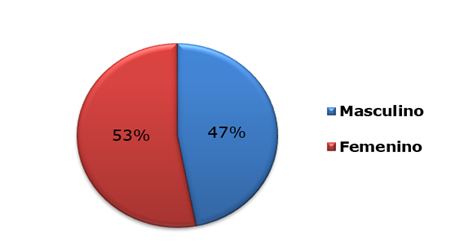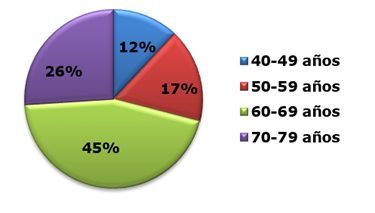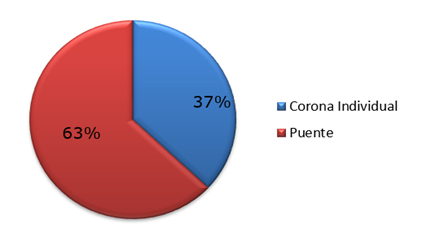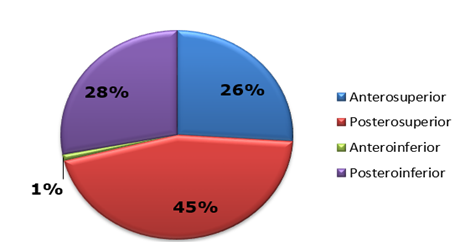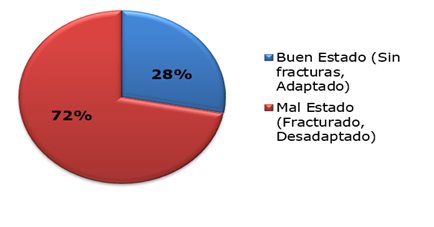Mi SciELO
Servicios Personalizados
Articulo
Indicadores
-
 Citado por SciELO
Citado por SciELO
Links relacionados
-
 Similares en
SciELO
Similares en
SciELO
Compartir
Revista de Ciencias Médicas de Pinar del Río
versión On-line ISSN 1561-3194
Rev Ciencias Médicas vol.27 supl.1 Pinar del Río 2023 Epub 01-Jul-2023
Articles
Status of dental prostheses in older adults of the Ciudad Verde urbanization, Santo Domingo, Ecuador
1 Universidad Regional Autónoma de Los Andes, Santo Domingo. Ecuador
ABSTRACT Introduction: prosthetic rehabilitation is not only the mere repositioning of teeth, but also the integration of the family and society, enabling the elderly to create ideal foods, avoiding the loss of teeth. Objective: to characterize patients with fixed partial dentures (FPP) in advanced age and the state of their dental prostheses, period January-December 2021, UNIANDES university. Methods: an observational, descriptive and cross-sectional study was designed to study the characteristics of patients with fixed partial dentures (FPP) and the state of their dental prostheses, in the period January-December 2021, attended at the UNIANDES university. The universe consisted of 250 patients, the sample consisted of 196 patients, structured on the basis of inclusion, exclusion and sampling criteria. The data were obtained from the patients' medical records. For the univariate and bivariate descriptive analysis, the following statistical tests were used: Student's t-test, Pearson's Chi-square and Fisher's exact test. Results: the univariate descriptive analysis showed that, of the total number of fixed prosthesis abutments, 63,2 % were single crowns and 36,8 % were bridge abutments. According to their location: 26 % of PPF were in the anterosuperior zone, 45,2 % in the posterosuperior zone, 28 % posteroinferior and 0,8 % anteroinferior. According to gingival status, mild gingivitis was found in 45,1%, moderate gingivitis in 51,6 % and severe gingivitis in 3,2 %. Regarding plaque retention, we found: presence of plaque 49,6 % and absence of plaque 50,4 %. Absence of mobility was found in 90,3 % of the cases and presence of mobility in only 9,7 %. Conclusions: The lost dental tissue should be replaced with a material that is biocompatible with the gingival tissues, does not allow plaque formation and does not contribute to gingival inflammation.
Key words: PERIODONTIUM; DENTURE, PARTIAL, FIXED; PREVENTION; TOOTH.
INTRODUCTION
One of the details that affect the oral health of older adults is the teeth. In the elderly, due to changes in facial contour, very active older people engaged in family and social activities need a fully secure prosthesis to be able to speak, eat, drink and improve aesthetics. past time. On the other hand, good dentition is essential to prevent conditions such as malnutrition and pronunciation problems.
Denture is not only the mere repositioning of dental resources, but also the integration of the family and society, enabling the elderly to create ideal food, avoiding the loss of teeth. The most important element of the functional part of a prosthesis in the elderly is the sterilization and maintenance of the prosthesis.1
The importance of hygiene should be emphasized and encouraged to avoid fad diets by substituting vegetables, lean meats and fruits, pastries, sweets and fruits so that their chewing system is partially or totally regenerated. Therefore, the dental team needs to be integrated with physicians, family and support staff.1
In older adult patients, prosthetic rehabilitations can be performed with a high success rate and without risk to their lives; surpassing conventional treatments with the limited benefit that this treatment offers if it does not comply with the necessary principles of retention support and stability.2
Among the factors that influence the use of dental prostheses are age, as an influential factor in the use of prostheses, but there is no statistical evidence that justifies that through aging dental loss increases.3 Gender, the female population over 48 years of age presents a greater risk of presenting osteoporosis, with a significant increase in risk of up to 64,3 % when they are over 50 years of age, the most visible characteristic being the loss of bone mass and the consequent possibilities of fracturing bone structures with the minimum of load application efforts.
Bone loss may necessitate frequent replacement of dental prostheses. This disease is more associated and progresses faster in women and appears shortly after menopause. Thus, studies reveal that the female gender presents more risk of dental loss in relation to age.4
The type of prosthesis can be considered as upper or lower, total or partial, and can affect the use or not of the prosthesis, but it is also determined by functional factors, anatomical and functional mechanisms.5
Total edentulousness causes serious problems in relation to esthetics and functionality; mobility and lack of attachment of the prosthesis in the mouth, makes chewing and speech difficult, besides triggering a process of bone resorption and atrophy causing continuous wear of the prosthesis. With the prosthesis treatment alternative, a stable anchorage is achieved that improves the quality of life of these patients.6
A constant concern of today's life is how to improve the quality of life, increasing longevity and enjoying every moment of life in the best way. No person can aspire to a better quality of life if he/she does not prioritize his/her state of health, the functional maintenance of each of his/her devices and systems, as well as his/her aesthetics and appearance.7
The main objective of the present study is to characterize the adult population that attends our center using dental prostheses and also to recognize which are the main difficulties that may exist in their use.
METHODS
An observational, descriptive and cross-sectional study was designed that addressed the clinical characteristics of patients with fixed partial dentures (FPP) of an advanced age, in the period January-December 2021, attended by students of the UNIANDES university. The universe consisted of 250 patients, the sample consisted of 196 patients whose clinical history was used.
The inclusion criteria were: patients received by students of the Faculty of Dentistry of the UNIANDES University, from 60 years of age and carriers of PPF. Exclusion criteria were: patients with orthodontic treatment, patients with medical treatment (last 6 months), patients with surgical treatment, patients with systemic diseases and patients diagnosed with periodontitis or under periodontal treatment.
A data matrix was used containing the following variables: gender, age, type of prosthesis, location. The variables: the condition of the fixed prosthesis was assessed as: good (adapted, without fracture) and bad (maladapted, fractured).
For the univariate and bivariate descriptive analysis, the following statistical tests were used: Student's t-test, Pearson's Chi-square and Fisher's exact test. A p value < 0,05 and the 95 % confidence interval were taken into account as the level of statistical significance.
The data were processed in the program Excel Version 2010 belonging to the Microsoft Office software package. The data are presented in graphs using relative frequencies (percentages). This research was approved by the Ethics Committee and the Scientific Council of the institution.
RESULTS
The results obtained in the present study show a higher prevalence of the female gender with 53 %; in this study, 47 % was found to be male (Graph 1).
In terms of age, the most frequent range was between 60 and 69 years of age (45%), followed by 50-59 years of age (17%). (Graph 2)
The type of fixed prosthesis most frequently found was: individual crowns (63,2 %) and bridges (36,8 %). These results show single crowns as the most frequent restorative treatment (Graph 3).
The most frequent location of fixed prostheses was in the posterosuperior area (45,2 %), followed by posteroinferior (28 %), anterosuperior (26 %), and anteroinferior (0,8 %). (Graph 4)
The dental prostheses were in good condition in only 28 % of the cases, showing that 72 % of the sample used prostheses in poor condition, taking into account the gingival condition, mobility, plaque retention and the time of use of these. (Graph 5).
DISCUSSION
Studies such as those of Cabanilla LL L et al,8 show a higher frequency of crowns and PPF in the upper jaw, affirming that the upper teeth receive these treatments earlier than the lower ones, and also show that molars and premolars have a greater tendency to develop caries or periodontal disease, and therefore require replacement or restoration earlier.
Regarding gingival status, it was found that 45,13 % presented mild gingival inflammation (values between 0-1), 51,62 % moderate gingival inflammation (values between 1.1-2) and 3,25 % severe gingival inflammation (values between 2.1-3). This can be compared with that described by Savadi A et al,9 stating that the fixed prosthesis tends to increase gingival inflammation, since it does not allow an optimal control of bacterial plaque.
The results of the present investigation are not compatible with Savadi A et al,9 who in 2007, after a systematic review, concluded that after 10 years, the estimated rate of fixed partial dentures without changes in mobility is 93,8 %, a very high result that corroborates the recommendations that with adequate controls and maintenance optimal periodontal conditions can be maintained.
Our study showed that the majority of patients were female (53 %), similar to the results of Medrano et al,10 in Chile, where they obtained that the majority of their population with dental prostheses was female; and in Peru with the results of Vargas K,11 obtaining within their sample of AM to 87 % of the female sex with dental prostheses.
Regarding the age group, our results showed that the greatest number of patients were of the old-elderly group, in agreement with Yen et al,12 where they obtained an average age of 76 years who used dental prostheses.
In San José, Costa Rica, a study showed that 70,7 % of the participants were denture wearers, 79 % of them had total upper dentures and 15 % total lower dentures, 4 % partial upper dentures and 2% total upper and lower dentures.13
CONCLUSIONS
Each impression material has unique properties that apply to all cases, as the impression techniques used in clinical evaluations of periodontal models before starting prosthetic surgery, the PVS-PE material seems to have an advantage over the plastic (polysulfide) which has an irreversible effect on the periodontal printed always in a healthy periodontal state. In order to achieve long-term esthetic and functional results, the clinician should make sure that the gingival tissue is healthy before starting the definitive preparation of the tooth, as well as at the time of cementing the fixed prosthesis, since a healthy periodontium will react in a predictable and positive way to the inevitable aggression of the dental intervention; on the other hand, in a pathological situation, the aggression will worsen the tissue conditions.
REFERENCIAS BIBLIOGRÁFICAS
1. Oliveira De Almeida E, Martins Da Silva EM, Rosse MF, Chagas A, Júnior F. Prótesis dental en el paciente anciano: aspectos relevantes. Rev Estom Herediana [Internet]. 2007 [Citado 03/04/2023]; 17(2): 104-107. Disponible en: Disponible en: https://www.redalyc.org/pdf/4215/421539348010.pdf 1. [ Links ]
2. Mateos-Nozala J, Alonso JC, Casado JM. Enseñanza de la Geriatría en el pregrado: ¿siguen las facultades de Medicina españolas las recomendaciones europeas? Rev Esp Geriatr Gerontol [Internet]. 2015 [Citado 03/04/2023]; 50(2): 71-73. Disponible en: Disponible en: http://www.sciencedirect.com/science/article/pii/S0211139X14002546 2. [ Links ]
3. Pennacchiotti Vidal G. Factores que influyen en el uso de prótesis removible en Adultos Mayores recién rehabilitados. Trabajo de investigación para optar el título de cirujano dentista [Tesis]. Universidad de Chile; 2005 [Citado 23/02/2023]. Disponible en: Disponible en: https://repositorio.uchile.cl/handle/2250/110761 3. [ Links ]
4. Ramos Díaz M, Hidalgo Hidalgo S, Rodríguez Rodríguez M, Lorenzo González G, Díaz Gómez SM. Alteraciones bucales en pacientes geriátricos rehabilitados con prótesis parciales. AMC [Internet]. 2005 Oct [citado 22/05/2023]; 9(5): 72-84. Disponible en: Disponible en: http://scielo.sld.cu/scielo.php?script=sci_arttext&pid=S1025-02552005000500009&lng=es 4. . [ Links ]
5. Gshwant BWS. Odontoestomatología en adultos mayores. Atención Gerontológica en Odontología. 3 era ed. Masson; 2010. [ Links ]
6. Estrada A, Cardona D, Segura AM, Marcela Chavarriaga L, Ordóñez J, Osorio JJ. Calidad de vida de los adultos mayores de Medellín. Biomédica [Internet]. 2011 [Citado 03/04/2023]; 31(4): 492-502. Disponible en: Disponible en: http://www.scielo.org.co/scielo.php?script=sci_arttext&pid=S0120-41572011000400004 6. [ Links ]
7. Robalino Espinoza SM. Influencia de la salud y calidad de vida de adultos mayores [Internet]. Guayaquil: Universidad Católica de Santiago de Guayaquil. Facultad de Ciencias Médicas; 2014 [Citado 03/04/2023]. Disponible en: Disponible en: http://repositorio.ucsg.edu.ec/bitstream/123456789/1901/1/T-UCSG-PRE-MED-ODON-106.pdf 7. . [ Links ]
8. Cabanilla LLL, Neely AL, Hernandez F. The relationship between periodontal diagnosis and prognosis and the survival of prosthodontic abutments: a retrospective study. Quintessence Int [Internet]. 2009 [Citado 03/04/2023]; 40(10): 821-31. Disponible en: Disponible en: https://europepmc.org/article/med/19898713 8. [ Links ]
9. Savadi A, Rangarajan V, Savadi RC, Satheesh P. Biologic perspectives in restorative treatment. J Indian Prosthodont Soc [Internet]. 2011 [Citado 03/04/2023]; 11(3): 143-8. Disponible en: Disponible en: http://dx.doi.org/10.1007/s13191-011-0101-x 9. [ Links ]
10. Medrano A, Ruiz-Calixto B, Gutiérrez C. Impacto en la calidad de vida relacionada con salud bucal de la rehabilitación protésica convencional en pacientes desdentados completos, atendidos en el servicio público chileno. Revista Científica Mundo de la Investigación y el Conocimiento [Internet]. 2017 [Citado 03/04/2023]; 1(4): 960-82. Disponible en: Disponible en: https://recimundo.com/index.php/es/article/view/57 10. [ Links ]
11. Vargas Duran K. Calidad de vida y salud bucal en usuarios de prótesis dental removible del centro integral del adulto mayor en Lima 2018 [Tesis]. Lima, Perú. Universidad Privada Norbert Wiener; 2018 [Citado 03/04/2023]. Disponible en: Disponible en: https://repositorio.uwiener.edu.pe/handle/20.500.13053/2875?locale-attribute=es 11. [ Links ]
12. Yen YY, Lee HE, Wu YM, Lan SJ, Wang WC, Du JK, et al. Impact of removable dentures on oral health-related quality of life among elderly adults in Taiwan. BMC Oral Health [Internet]. 2015 [Citado 03/04/2023]; 1(5): 15:1. Disponible en: Disponible en: https://www.ncbi.nlm.nih.gov/pmc/articles/PMC4298049/ 12. [ Links ]
13. Arce WP. Propuesta de un Plan de Mejora de la Salud bucodental en el Hogar del Adulto Mayor Alfredo y Delia González Flores de San Pablo de Heredia. Instituto Centroamericano de Administración Pública [Internet]. San José, C.R; 2012 [Citado 03/04/2023]; Disponible en: Disponible en: http://biblioteca.icap.ac.cr/BLIVI/TESIS/2012/arce_ramirez_william_sa_2012.pdf 13. [ Links ]
Financiación
Received: May 18, 2023; Accepted: May 23, 2023











 texto en
texto en 

